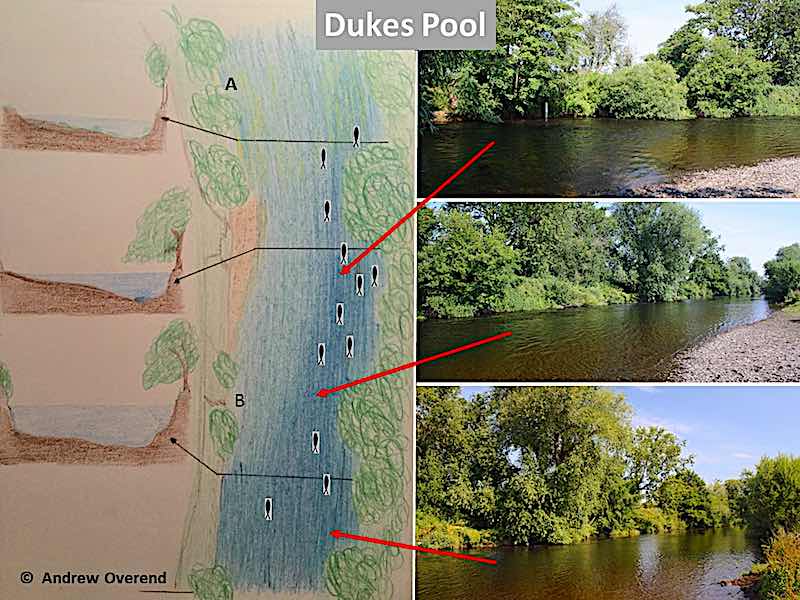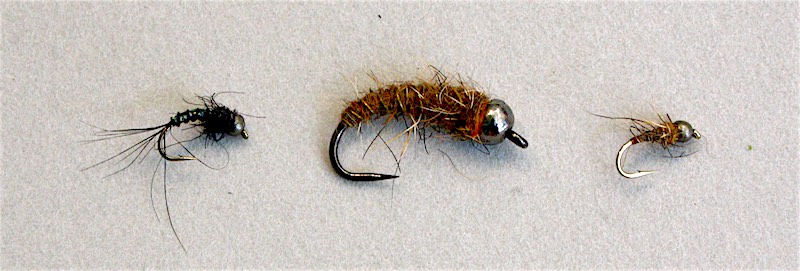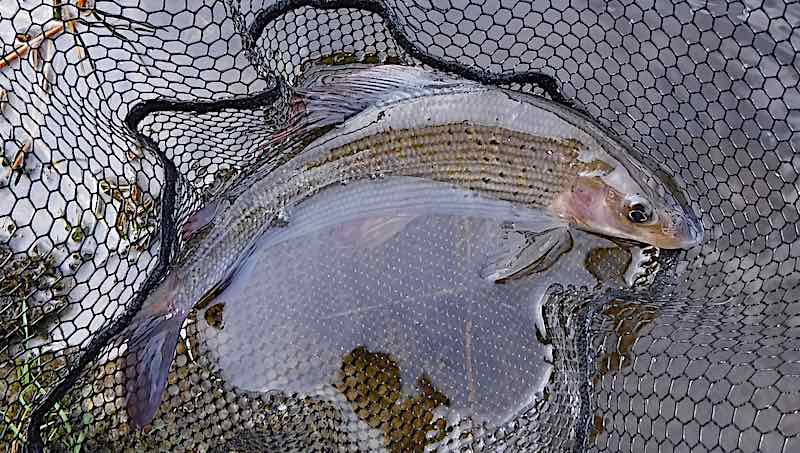Subscribe to my blog
Make your life easier - my blog posts delivered directly to your inbox.
Hawker-Overend Fishing

Dukes Pool is a popular pool on the Village beat because it is easily reached by a short walk from parking in the village.
Grayling and trout are your main quarry when fishing Dukes pool. In addition, salmon are occasionally caught when fishing the pool with the fly and spinner.
On working through this guide, you will learn the different approaches I employ for catching grayling, brown trout and salmon; and how best to adjust your approach for different river & weather conditions.
Dukes Pool is on the Village beat and is located below the Old Bridge in Bangor-on-Dee. It is reached by taking the footpath near the entrance to the Royal Oak Pub car park. The pool is about 100m downriver at the first clearing between the trees.
At the end of this guide, a Google direction locator has been added to help with directions.
Over the years, I’ve caught plenty of trout & grayling while fly fishing Duke’s Pool; especially, when the river is close to its summer level (ca. 0.5m @Manley Hall gauge).
The distribution of fish throughout Dukes Pool is dependent on river height. Therefore, my approach to fishing this pool depends on a combination of river level and the extent of surface fly-life activity.
Below is a topographic sketch of Dukes Pool that shows its key features and where I usually catch trout and grayling while fly fishing when the river is at its summer level.

This section of the Welsh Dee fishing guide for Dukes Pool covers fly fishing for grayling on the Welsh Dee, my attention turns to fly fishing for grayling from October to the end of February. There are many good pools for grayling fly fishing on the Village beat and Dukes Pool is one of them
Dukes Pool is best fished when the river is below 0.65m (Manley Hall gauge). If the river is close to its summer level grayling lie in the faster water close to the tree-lined far bank. At higher levels, grayling get pushed into the body of the pool where the flow eases closer to the near bank.
After considering the river level, my approach to fishing this pool is influenced by signs of surface fly activity.
On cold mornings, when there is no fly life activity, it is usually best to start by searching the river bed with a team of nymphs. Since grayling are likely to be grubbing on the riverbed for food.
Nymph selection depends on several conditions that are covered in detail on the fly fishing technique page. Below is a typical example of a team of nymphs I will use when the river is running clear.
The heavy nymph is used to drag the small nymphs to the river bed quickly.
Often, I fish the heavy nymph on the point but if grayling are predominately taking the middle dropper I will move the heavy nymph up to the middle dropper. This ensures that both small nymphs are fishing close to the riverbed, which can increase the catch rate. However, it can lead to more snag-ups.

In coloured water, I will tend to use larger nymphs that have a bright spot (e.g. colourful tungsten beads, bright tags, etc). Below is a typical example of a team of nymphs I will use when the river is coloured.
Additional examples can be found in the fly fishing technique page devoted to Czech nymphing.
If the river is close to its summer level (< 0.5m @ Manley Hall gauge, I start fishing in the riffle above the pool (point A) and fish my way across and downriver in a zigzag fashion. At higher river levels I start fishing on the gravel bank lower down.
Grayling are normally found in the oxygenated sections of the pool: the riffle, around the drop-off zone and close to the vegetation on the far bank. In these areas focus on the zones of slower flow caused by riverbed features (i.e. weed beds, boulders, snags etc.).
I stop fishing the pool at point B because it becomes too deep to wade beyond that point.
In the sketch of Dukes Pool, above, I’ve highlighted the hot spots where I typically catch most fish. However, because grayling move around don’t ignore other parts of the pool.
The following video shows me fishing the riffle leading into the main pool.

The tree-lined far bank offers plenty of shelter when the river is low and hence supports a good head of trout and grayling. In high water, it can be fished from the bank or by carefully wading close to the right bank.
Often, I switch to fishing the pool with wet flies when nymphing doesn’t catch anything, or when the catch rate fades because grayling have started to take flies higher in the water column. The latter usually happens…
“around mid-day due to a surface temperature rise”.
When it’s not possible to identify what flies grayling are feeding on, I will start with one of my workhorse teams of wet flies/spiders spaced 3ft apart on a 3lb copolymer leader, depending on the time of year.
Default autumn wet fly team (sizes 16 to 14):
Default Winter wet fly team (sizes 16 to 14):
If after 15 – 20 minutes, I haven’t had any takes, I start trying other patterns until success comes. That said, the workhorse teams rarely fail to catch grayling.
I find it best to start fishing the wet flies/spiders in the tail of the pool (point B) and methodically working upriver. Casting the flies upriver at a 45-degree angle and allowing them to dead-drift downriver. When the flies drift downstream of me, I mend the line to slow the swing to the dangle.
Even if grayling are rising close to the far bank, it is often wise to resist the temptation to cast directly at them.
A better approach is to divide the river into 3ft lanes and search each lane before the lane holding the rising fish. This often yields extra grayling that you have not seen and would have been spooked by casting over them.
If there is a strong downstream wind, I find it best to start at the head of the pool (point A) and fish the wet flies across and downstream.
I have a separate page on Wet Fly fishing that has more information on the approach I find successful.

Even in winter when there’s no sign of surface fly life grayling can be tempted to take a dry fly. This is especially so when they are lying in less than 3 feet of water.
When the Welsh Dee is close to its summer level, most of the top section of Duke’s Pool is less than 4ft deep. Therefore, when fishing this part of the pool it’s best to cover likely lies with the dry fly, before casting to rising grayling.
Usually, I switch to the dry fly when fish are constantly rising to emerging dry flies or rising close to obstacles such as overhanging trees or exposed rocks and ledges. No surprising fly choice depends on what is hatching.
It’s best to base fly choice on imitating flies that are hatching. However, if this is not possible one of the following will usually catch grayling from October onwards:
If after 15 minutes, I haven’t had any takes, I start trying other patterns until success comes. That said, the workhorse teams rarely fail to catch grayling.
I find it best to start fishing the dry fly in the tail of the pool (point B) and methodically working upriver. Casting the flies upriver at a 45-degree angle and allowing them to dead-drift downriver.
Even if grayling are rising close to the far bank, it is often wise to resist the temptation to cast directly at them.
A better approach is to divide the river into 3ft lanes and search each lane before the lane holding the rising fish. This often yields extra grayling that you have not seen and would have been spooked by casting over them.
If you are interested in learning more about the various flies that I find work on the Welsh Dee from October to February then it is worth reading the following post:
This section of the Welsh Dee fishing guide covers fly fishing for brown trout.
The brown trout season on the Welsh Dee starts on the 3rd March. At this time of year, the weather is often more like winter than spring. Therefore, my approach to fly fishing for brown trout is similar to that described for autumn & winter grayling above.
Once April arrives, the weather usually starts to warm up and hatches of Large Dark Olive, March Brown and other olives become more frequent from mid-morning to mid-afternoon. This provides more opportunities to catch brown trout on the dry fly, by matching the hatch.
As May approaches fly hatches become more prevalent and brown trout are keen to intercept emerging fly life. This is when dry-fly and upstream wet-fly fishing often yield the best results. Unless the river is carrying some colour when Czech nymphing generally produces better results.
The river flows in a northerly direction through Dukes Pool and on sunny days it is too bright to fish this pool from 11 am to 4 pm. Therefore, it’s best to fish this pool early morning and late evening.
On dull, overcast days this pool can be fished throughout the day, but the fishing still slows between 1 and 4 pm. Making this a good time for a break before resuming the challenge in the evening.

This section of the Welsh Dee fishing guide covers fly fishing for salmon.
The tree lined far bank offers shelter for salmon when the river is low. In high water, it can be fished from the bank or by carefully wading close to the right bank.
To date, I have not managed to catch any salmon from Dukes pool. Therefore, the following advice is based on talking to anglers who have had more success than me and where I have seen fish show over the years.
In low water conditions, salmon hold in the deeper water close to the far bank, sheltered by the overhanging trees on the far bank. Therefore, its important to cast the fly as close to the far bank as possible and let it swing around to the dangle. Don’t be in a hurry to recast because salmon can slow in taking the fly on the dangle.
In high water, fish tend to lie closer to the near bank and the deeper water close to the end of Dukes Pool. Under these conditions, it is always best to fish the pool from the bank because they can be tucked quite close to the bank. Then if it’s safe wade, fish through the pool again because this will change the position at which the fly will come round to the dangle.
This is a very good question and is one I have struggled with for many years of fishing the Welsh Dee. There is likely to be an answer but you need to be catching 30+ salmon per year to end up with a statistically significant answer.
Therefore, I use the following simple strategy:
My reason for a simple fly selection strategy is that on the Welsh Dee, the more important question is…
Once you’ve identified a potential lie, your attention should be focused on how best to cover the fish so it will take your offering.
I’ve found salmon are either in taking mode or not…
Most of the salmon I have caught have been on the first run through the pool. Therefore, fish the pool quickly and move on to the next one. The aim is to cover as much of the river as possible in search of the taker.
A side benefit of this strategy is that you get plenty of exercise which keeps you fit!!!
Finally, I hope you have found this Welsh Dee fishing guide for Dukes Pool interesting and informative.
Take the footpath to the river just below the Old Bridge near the entrance to the Royal Oak Pub car park. Dukes Pool is about 100m downriver at the first clearing between the trees.
Before visiting please check that access to this beat has not changed on the Bangor-On-Dee Salmon Anglers website.
[Disclaimer – like most outdoor sports, fishing is not without its hazards. Therefore, you MUST do your RISK ASSESSMENT before starting to fish; especially if you decide to wade and/or fish at night. In addition, before fishing at Dukes Pool you must follow the Bangor-On-Dee Salmon Anglers Club rules ]
Subscribe to my blog
Make your life easier - my blog posts delivered directly to your inbox.